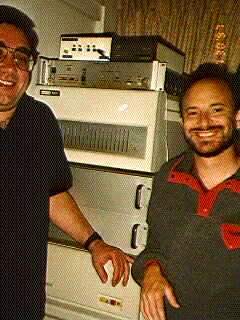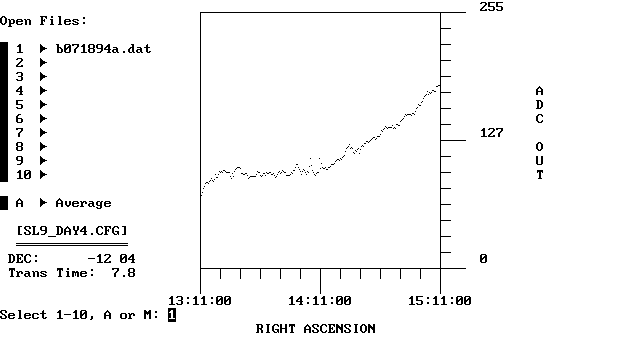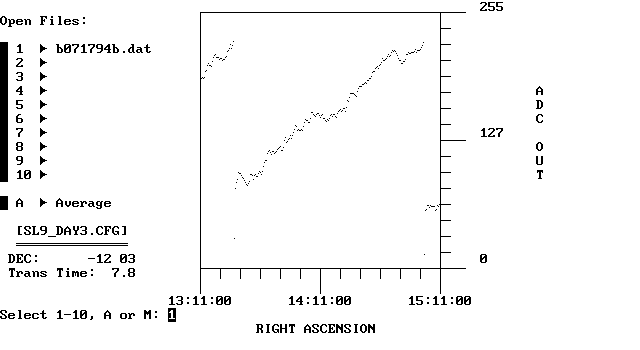|
BAMBI
Observations of Comet S/L-9 Impact on Jupiter
|
Here are the results from BAMBI's observations of comet Shoemaker-Levy
9's impact on Jupiter:

Photo: The BAMBI-A High Speed ADC, NIST Modem, Downconverters, Power
Supply,
Radio Telescope Electronics Bay, Spectrum Analyzer Bay, and a support
pedestal
(the pedestal is a vintage PDP-11/23, just for fun. No, we have not
needed to use it for anything else in this project!)
Mike F. is the one who is sort of cut in half on the left. The fellow
cut in half on the right is Mike Fremont.
Observation Report
for the SARA Jupiter Comet Watch Program
from the Project BAMBI Amateur Radio Telecope
at 4.213 GHz
==============================================
rev. 9/21/94
By Bob Lash and Mike Fremont
Project BAMBI
bob@bambi.net
A pair of radio bursts were detected at 1:19:28 UT and 1:23:55 UT on 7/20/94
corresponding with the transit of Jupiter through the main beam of the
BAMBI Radio Telescope. This also correlated with the massive fragment L
impact site which was at the central meridian of Jupiter at the observed
burst times (and was beginning its first rotation around Jupiter).
The power level of each burst was estimated based on calibration runs done
on CASS A, TAU A, and VIRGO A and a best fit square law detection curve.
The results are summarized below:
Designation Center Time UT RA Burst Duration Jy (Est.) at 4 GHz
----------- -------------- --------- -------------- ------------------
Burst B1 1:19:28 14:06:11 4 - 5 minutes 355 Jy
Burst B2 1:23:55 14:10:39 4 - 5 minutes 274 Jy
Jupiter was at RA 14:11:00 and DEC -12 04.
The half power beamwidth transit time for drift scans at this declination
(-12 04 DEC) and beamwidth (1.9 degrees for our 8.5 ft dish) is 7.8 minutes,
so the majority of Jupiter's received power would be predicted to be from
14:11:00 - 3.9 minutes to 14:11:00 + 3.9 minutes, or in other words from RA
14:07:00 to 14:15:00. There is also a +- 30 second error in data logging
resolution. Therefore both bursts fit the beam pattern expected for a Jupiter
transit.

The recording (see Fig. 1 above)
on this day shows the usual radio telescope baseline variation,
but the two spikes near 14:11:00 are considerably "sharper" in shape, strong,
and suggestive of a transient burst rather than the bell shaped pattern
seen when a steady radio source (e.g. SNR) transits the beam.
(Note: Prior to the SL9 impact, 10 nights of Jupiter scans were averaged
to precisely fix the RA calibration. The actual RA is dervived from the
coarse RA in the data log file plus the above RA correction of 5 minutes.
All RA's mentioned are actual).
While observations from one radio telescope cannot prove that the measured
radio bursts were caused by the Fragment L site, there is certainly a
correlation. It is interesting to note that Jupiter was only in the
telescope beam for 7.8 minutes out of every 24 hour period, and the largest
fresh impact that could have been seen, due to impact timing, was in fact
fragment L. No such bursts were seen on any other night during the encounter.
Correlation with the next most recent fragments seems unlikely since at the
time of the bursts Fragment K was already on its 2nd rotation and almost
out of view on the limb, and Fragment H was 4 rotations old and behind
Jupiter at that time.
We would also like to report that a bell-shaped enhancement that matched
the beam pattern occured precisely as Jupiter crossed the beam at 1:27:00
UT on 7/19/94 (see fig. 2 below):

There were no fresh impact sites in the beam at that time, and no radio
bursts were found. We would be very interested to hear from anyone
who have any theories about this one! We did not find bell-shaped
enhancements on any other night.
It is our hope that this data may help others confirm their own findings.
If you are aware of confirming data, please let us know!
BAMBI Home | What's New | Software | Jupiter Observations | SARA / Amateur Radio Astronomy


